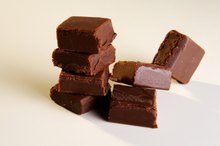Signs of a Chocolate Allergy
True allergy to cocoa is rare. Most likely an allergy to or intolerance of other ingredients in chocolate or chocolate desserts, such as soy or dairy, is causing symptoms. You might also be sensitive to the natural chemicals in chocolate. Chocolate allergy symptoms can show within minutes or within several hours after you eat chocolate, and can range from rashes to trouble breathing. Severe symptoms require emergency treatment.
If you are experiencing serious medical symptoms, seek emergency treatment immediately.
Suspect Ingredients
Even chocolate that does not contain nuts can be made on machinery used to manufacture products that do contain nuts. The label should alert you to this. Chocolate may even contain nickel and often contains trace parts of cockroaches, that hang out around the cocoa beans. Natural chemicals in chocolate, including caffeine, can also cause problems.
- Even chocolate that does not contain nuts can be made on machinery used to manufacture products that do contain nuts.
Itching and Rashes
Symptoms of Allergies to Chickpeas and Soy
Learn More
Food allergies, including chocolate allergy, commonly cause:
- hives
- a bumpy red
- itchy rash,
- ezcema
- a flat
- dry
- itchy rash 2
Your ears, mouth or rectum may itch. Your skin may appear red.
Respiratory Symptoms
A dry cough, sneezing and a runny or stuffed-up nose are common symptoms of food allergy 1. Call 911 if the respiratory symptoms turn severe, such as trouble breathing.
Gastrointestinal Upsets
Allergic Reactions to Soy Milk
Learn More
Chocolate allergy, like all food allergies, can upset your digestive system, resulting in heartburn, stomachache, nausea, vomiting or diarrhea 2. You might also experience an odd taste in your mouth.
Headaches
A sensitivity to one of the natural chemicals in chocolate, such as:
- caffeine
- theobromine
- phenylethylamine
- tyramine
- can cause headaches
Chocolate is one of the foods that people who experience migraines are urged to avoid.
Severe Symptoms
A severe chocolate allergy can trigger anaphylaxis, a condition that can become life-threatening. Signs of anaphylaxis can include:
- wheezing or shortness of breath
- chest pain
- panic
- confusion
- a weak pulse
- dizziness,
- swelling of the mouth
- tongue or throat to the point that it interferes with swallowing or breathing
If you or someone else experience serious symptoms, get emergency help.
Related Articles
References
- Food Allergy Research & Education: Symptoms
- University of California, Berkeley Health Services: Migraine Triggers
- ABC News: Bugging Out - Chocolate Allergy Linked to Roaches
- American Academy of Allergy, Asthma & Immunology. Chocolate allergy and cocoa butter. 2017.
- FoodData Central. Chocolate, sweet or dark. U.S. Department of Agriculture. 2019.
- Katz DL, Doughty K, Ali A. Cocoa and chocolate in human health and disease. Antioxid Redox Signal. 2011;15(10):2779-811. doi:10.1089/ars.2010.3697
- National Institutes of Health News on Health. Claims about cocoa. 2011.
- Higginbotham E, Taub PR. Cardiovascular benefits of dark chocolate?. Curr Treat Options Cardiovasc Med. 2015;17(12):54. doi:10.1007/s11936-015-0419-5
- American Academy of Allergy, Asthma & Immunology. Chocolate allergy and cocoa butter. 2017.
Writer Bio
From 1978 until 1995, Virginia Van Vynckt worked as a writer and editor at The Chicago Sun-Times. She has written extensively about food and nutrition, having co-authored seven cookbooks. She also published "Our Own," a book about older-child adoption. Van Vynckt holds a Bachelor of Arts degree in journalism from Indiana University.









